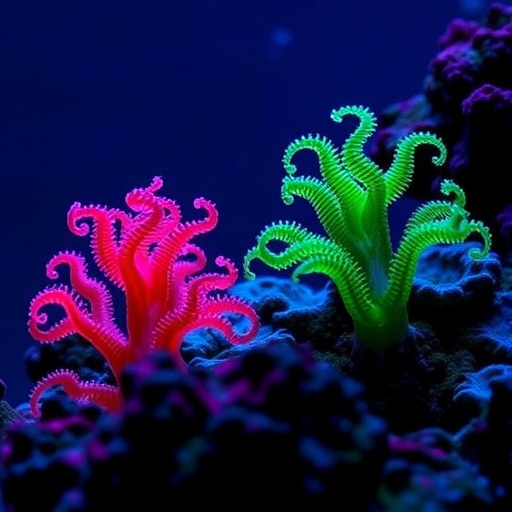In a groundbreaking study, researchers have delved into the complex subcellular dynamics of an intriguing sponge specialist from the Symbiodiniaceae family, specifically focusing on the organism known as Gerakladium spongiolum. This sponge symbiont, which thrives in diverse marine environments, showcases a remarkable ability to adapt its cellular components in response to varying environmental conditions. Understanding the mechanisms behind such adaptability not only contributes to the field of marine biology but also provides insights that may have broader implications for ecosystem resilience amid global climate change.
One of the most fascinating aspects of Gerakladium spongiolum is its ability to alter its pyrenoid structures throughout different times of the day. Pyrenoids are specialized organelles found within chloroplasts that play a critical role in carbon fixation. This dynamic change serves as a strategic adaptation, optimizing photosynthetic efficiency depending on light availability. Researchers measured variations in pyrenoid morphology and abundance, revealing a robust plasticity that suggests this organism has evolved to maximize its energy acquisition.
As sunlight filters through ocean waters, the chloroplasts of Gerakladium spongiolum exhibit their own form of plasticity. These small but vital organelles are responsible for photosynthesis, converting light energy into chemical energy. The study observed significant diel changes in the size and number of chloroplasts, correlating with the light cycle. For instance, during peak sunlight hours, chloroplasts were observed to increase in size and number, enhancing the sponge’s ability to harness energy from its environment. This synchronization with the diurnal rhythm is a testament to the organism’s intricate connection to its habitat.
Examining granules within Gerakladium spongiolum added another layer of understanding of its subcellular adaptations. Granules serve as storage sites for carbohydrates and other essential compounds, enabling the sponge to maintain energy reserves during periods of low light. The study documented fluctuations in granule quantity and composition throughout the day, suggesting a finely-tuned metabolic strategy for energy conservation and utilization. This phenomenon highlights the sponge’s remarkable aptitude for survival in fluctuating environmental conditions.
Moreover, the research sheds light on how these subcellular changes contribute to the sponge’s overall health and functionality. The ability to efficiently process light and manage energy reserves directly influences the sponge’s growth, reproduction, and resilience against stressors such as rising temperatures or ocean acidification. Such insights are critical as scientists work to understand the potential impacts of global climatic shifts on marine ecosystems.
Neurotoxic compounds often threaten coral reefs, but Gerakladium spongiolum has shown a remarkable ability to cope with these challenges. By studying the sponge’s interaction with its native environment, the researchers found that enhanced phenotypic plasticity allowed it to counteract the adverse effects of toxins, suggesting evolutionary advantages for adaptation in stressed habitats. These findings underscore the sponge’s significant role in maintaining coral reef health.
Moreover, the study highlights the importance of symbiotic relationships within marine ecosystems. The partnership between Gerakladium spongiolum and its sponge host is a striking example of mutualism, where both organisms benefit from their interaction. The sponge provides a stable habitat for the symbionts, while the phytoplankton contribute to the sponge’s nutritional needs through photosynthesis. Such intricate biological relationships support ecosystem stability and resilience.
Researchers also emphasize the need for further exploration into how climate change affects these adaptive traits. As ocean temperatures rise, understanding the physiological responses of marine organisms like Gerakladium spongiolum becomes increasingly crucial. Mitigating the impacts of environmental stressors requires a deep understanding of how these organisms can adjust their biological functions in real-time.
In summation, the discoveries surrounding Gerakladium spongiolum illuminate the complex interplay of biology and environment in marine ecosystems. Through their subcellular plasticity, these sponges exemplify the evolutionary creativity of life in the ocean, showcasing adaptations that are critical for survival in a rapidly changing world. The findings not only contribute substantially to marine biology but also provide a framework for evaluating other marine organisms’ adaptive strategies under climate change pressures.
This research serves as a clarion call for the scientific community, urging further investigation into the plasticity of symbiotic organisms. It invites a reevaluation of how we consider cellular adaptations in the face of environmental challenges. As we stand on the brink of significant ecological shifts, understanding the resilience mechanisms of organisms like Gerakladium spongiolum may well be our best bet for predicting and possibly mitigating the impacts of climate change on marine biodiversity.
Ultimately, the story of Gerakladium spongiolum is one of adaptation, resilience, and survival. As researchers continue to investigate the mysteries of this sponge specialist, the knowledge gained will undoubtedly pave the way for new strategies aimed at conserving marine ecosystems and can inspire future generations of scientists and conservationists to delve deeper into the wonders and complexities of our planet’s oceans. The journey through the subcellular world of this sponge represents a microcosm of life in the ocean, reminding us of the incredible adaptability that defines organisms in one of Earth’s most vital habitats.
Subject of Research: Subcellular traits of Gerakladium spongiolum
Article Title: Diel changes in subcellular traits of an intracellular Symbiodiniaceae sponge specialist: pyrenoid, chloroplast, and granule plasticity in the symbiont Gerakladium spongiolum.
Article References: DuMez-Kornegay, R., Lacy, C. & Hill, M. Diel changes in subcellular traits of an intracellular Symbiodiniaceae sponge specialist: pyrenoid, chloroplast, and granule plasticity in the symbiont Gerakladium spongiolum. Coral Reefs (2025). https://doi.org/10.1007/s00338-025-02718-6
Image Credits: AI Generated
DOI:
Keywords: Symbiodiniaceae, Gerakladium spongiolum, subcellular plasticity, chloroplasts, pyrenoid, granules, marine biology, coral reefs, climate change.




